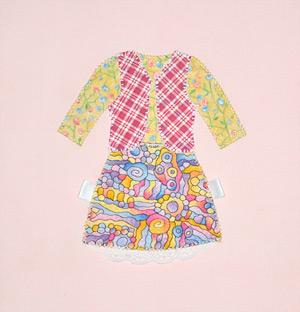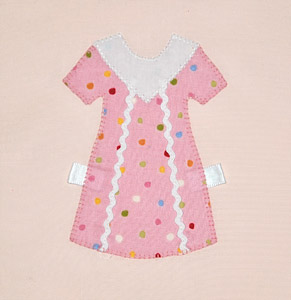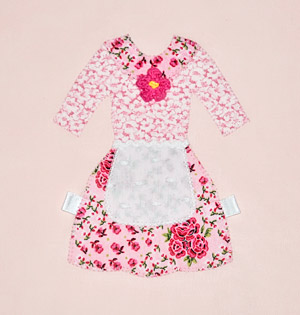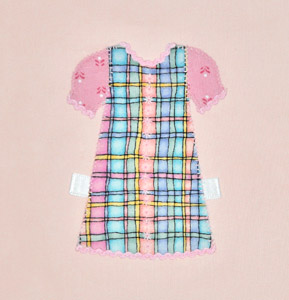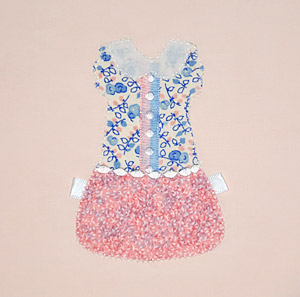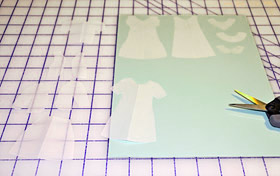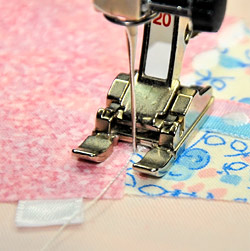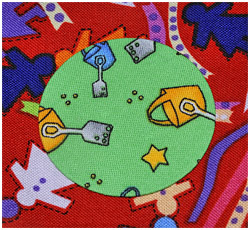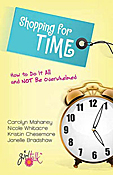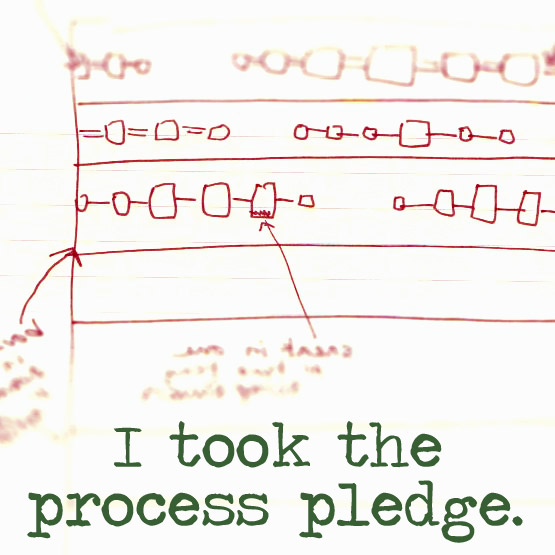My latest paper doll block has a western feel to it with its pink plaid vest. I also added a little ruffled lace to the hem of the skirt.
Before constructing block five, please read the introduction to this series where you will find helpful information. You may also want to read through the instructions for blocks #1-4 since one tutorial builds on another.
Download the following PDF files from BOX in the right margin: 12_LS Boat-Neck Top Applique, 13_ A-Line Skirt Applique, 14_ Vest Applique.
Roughly cut out the printed applique pieces and adhere them to card stock. Now cut them out true-to-shape. These will serve as your templates.
Outline the three templates onto double-sided fusible web. Flip the vest template to its mirror image and outline it as well.
Roughly cut out the shapes and adhere them to the back of your chosen fabrics.
Carefully cut out each applique shape.
From a pastel cotton fabric, cut a 7 ½-inch background square. (Kona cotton is a good choice.) Starch and press the square and adhere a light tear-away stabilizer to the back.
Mark the center of your square background block. (It is helpful to fold a vertical and horizontal crease into the center of the background square.) Measure the height of the applique and place a piece of tape at the top and bottom placement points. This insures that the applique will be centered correctly.
Cut a 4 ½” piece of lace and ruffle it by sewing a 4.0mm straight stitch along the top edge.
Peel off the backing paper and position the top and a-line skirt onto the background square. Tuck the lace under the hemline of the skirt and finger press down.
Cut two 1 ¼” sections from 3/8” wide white satin ribbon. Fold in half and finger press. Place one folded tab on each side of the lower skirt by carefully lifting the edge of the applique and tucking the raw edges of the tab underneath. Finger press the area to re-adhere the fusible.
Following the package instructions, press the applique pieces in place. Always use a pressing cloth for this step.
Set up your sewing machine with a thread color that matches the top and skirt fabrics. Blanket stitch around the sides and bottom of the skirt using a 2.3mm length and 2.0mm width. If your sewing machine doesn’t have a blanket stitch, simply use a zig zag stitch.
Change to a satin stitch and stitch across the waistline of the skirt.
Using a straight stitch, stitch up the side of the top. This part of the applique will be covered by the vest.
When you reach the sleeve area, change to a blanket stitch and continue stitching until you reach the opposite side of the top.
Straight stitch down to the waistline.
Position the vest pieces in place and press.
Blanket stitch around both vest appliques. Change thread colors if necessary.
Gently remove the backing stabilizer.
Block five is now complete! Save all your templates so that you can mix-and-match more paper doll outfits in the future.
Check back soon for block six.
Happy stitching,
Nancy
~~~~~~~~~~~~~~~~~~~~~~~~~~~~~~~~~~~~~~~~~~~
My dh and I just returned from Grand Rapids where I took this picture of Lake Michigan. The weather was cool and breezy all week making it a perfect trip from beginning to end. Isn’t the lake awesome?

